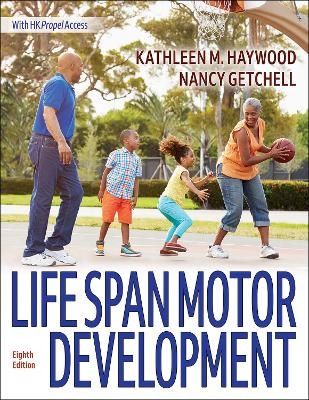
Life Span Motor Development
Human Kinetics (Verlag)
978-1-7182-1672-3 (ISBN)
Life Span Motor Development, Eighth Edition With HKPropel Access, is a leading text for helping students understand a person’s movement abilities as the interaction of the individual’s development and maturation, the environment, and the task being performed. This model of constraints approach, combined with an unprecedented collection of video clips marking motor development advancements, facilitates an unmatched learning experience for the study of motor development across the life span.
Life Span Motor Development helps students understand how maturational age and chronological age are distinct and how functional constraints affect motor skill development and learning. It shows how the four components of physical fitness—cardiorespiratory endurance, strength, flexibility, and body composition—interact to affect a person’s movements over the life span, and it describes how relevant social, cultural, psychosocial, and cognitive influences can affect a person’s movements. It also now includes more content on atypical development; new Spotlight on Disability sidebars help readers use the constraints perspective to better understand how various disabilities influence motor development.
The eighth edition continues the tradition of making the student’s experience with motor development an interactive one. Related online learning tools delivered through HKPropel include an updated video library with more than 200 video clips, showing motor development milestones, to sharpen observation techniques; flash cards; key term quizzes; and 48 lab activities (including one new to this edition) to facilitate critical thinking and hands-on application. Some lab activities may be assigned and tracked by instructors through HKPropel, and sample answers for the lab activities are found in the instructor guide. Chapter quizzes are automatically graded to test comprehension of critical concepts.
This edition features updated, modernized artwork and includes 142 illustrations, 60 photos, and 24 tables—all in full color—to help explain concepts and to make the text more engaging for students. It also retains helpful learning aids, including chapter objectives, a running glossary, key points, sidebars, and application questions throughout the text. Each chapter begins with a section titled Motor Development in the Real World, which presents realistic experiences that help readers connect with the material. Each chapter ends with a section titled Reinforcing What You Have Learned About Constraints, which prompts readers to answer questions about the material and complete learning exercises. Answers to these questions are included in the instructor guide.
Life Span Motor Development, Eighth Edition, embraces an interactive and practical approach to illustrate the most recent research in motor development. Students will come away with a firm understanding of the concepts and how they apply to real-world situations.
Note: A code for accessing HKPropel is included with all new print books.
Kathleen M. Haywood, PhD, is a professor emerita at the University of Missouri at St. Louis, where she has researched life span motor development and taught courses in motor behavior and development, sport psychology, and biomechanics. She earned her PhD in motor behavior from the University of Illinois at Urbana-Champaign in 1976. Haywood is a fellow of the National Academy of Kinesiology and the Research Consortium of SHAPE America (Society of Health and Physical Educators). She is also a recipient of SHAPE America’s Mabel Lee Award. Haywood has served as president of the North American Society for the Psychology of Sport and Physical Activity and as chairperson of the Motor Development Academy of SHAPE America. Haywood is also the coauthor of Archery: Steps to Success, published by Human Kinetics. She resides in Saint Charles, Missouri, and in her free time enjoys fitness training, pickleball, and dog training. Nancy Getchell, PhD, is a professor at the University of Delaware in Newark, where she serves as the director of the developmental motor control research laboratory. For over 30 years, Getchell has investigated developmental motor control and coordination in children with and without disabilities. Her current research focus is on brain–behavior relationships in children with developmental coordination disorder and other conditions. She teaches courses in motor development, motor control and learning, research methods, and women in sport. Getchell has served on the executive committee of the International Motor Development Research Consortium and is a professional member of SHAPE America and the North American Society for the Psychology of Sport and Physical Activity. She is a fellow of the National Academy of Kinesiology, the Research Council of SHAPE America, and the International Motor Development Research Consortium. In 2024, she was the inaugural Lolas Halverson Lecturer for the SHAPE America convention in Cleveland, Ohio. Getchell resides in Wilmington, Delaware, where she enjoys hiking, geocaching, and bicycling.
Part I. Introduction to Motor Development
Chapter 1. Fundamental Concepts
Defining Motor Development
Constraints: A Model for Studying Motor Development
How Do We Know It Is Change?
A Developmental Paradox: Universality Versus Variability
Summary and Synthesis
Chapter 2. Theoretical Perspectives in Motor Development
Maturational Perspective
Information Processing Perspective
Ecological Perspective
Current Interests
Summary and Synthesis
Chapter 3. Principles of Motion and Stability
Understanding the Principles of Motion and Stability
Using the Principles of Motion and Stability to Detect and Correct Errors
Summary and Synthesis
Part II. Development of Motor Skills Across the Life Span
Chapter 4. Early Motor Development
How Do Infants Move?
Why Do Infants Move? The Purpose of Reflexes
Motor Milestones: The Pathway to Voluntary Movements
Development of Postural Control and Balance in Infancy
Summary and Synthesis
Chapter 5. Development of Human Locomotion
The First Voluntary Locomotor Efforts: Creeping and Crawling
Walking Across the Life Span
Running Across the Life Span
Other Locomotor Skills
Summary and Synthesis
Chapter 6. Development of Ballistic Skills
Overarm Throwing
Kicking
Punting
Sidearm Striking
Overarm Striking
Interventions
Summary and Synthesis
Chapter 7. Development of Manipulative Skills
Grasping and Reaching
Catching
Anticipation
Summary and Synthesis
Part III. Physical Growth and Aging
Chapter 8. Physical Growth, Maturation, and Aging
Prenatal Development
Postnatal Development
Summary and Synthesis
Chapter 9. Development and Aging of Body Systems
Systems Development During the Prenatal Period
Systems Development During Childhood and Adolescence
Systems Development During Adulthood and Older Adulthood
Summary and Synthesis
Part IV. Development of Physical Fitness
Chapter 10. Development of Cardiorespiratory Endurance
Physiological Responses to Short-Term Exercise
Physiological Responses to Prolonged Exercise
Summary and Synthesis
Chapter 11. Development of Strength and Flexibility
Muscle Mass and Strength
Development of Strength
Development of Flexibility
Summary and Synthesis
Chapter 12. Weight Status, Fitness, and Motor Competence
A Model of Interrelationships
Body Composition
Obesity
Motor Competence, Activity, Fitness, and Body Composition
Summary and Synthesis
Part V. Perceptual-Motor Development
Chapter 13. Sensory-Perceptual Development
Visual Development
Kinesthetic Development
Auditory Development
Intermodal Perception
Summary and Synthesis
Chapter 14. Perception and Action in Development
The Role of Action in Perception
Postural Control and Balance
Summary and Synthesis
Part VI. Functional Constraints in Motor Development
Chapter 15. Social and Cultural Constraints in Motor Development
Social and Cultural Influences as Environmental Constraints
Other Sociocultural Constraints: Race, Ethnicity, and Socioeconomic Status
Summary and Synthesis
Chapter 16. Psychosocial Constraints in Motor Development
Self-Esteem
The Link Between Perceived and Actual Motor Competence
Motivation
Summary and Synthesis
Chapter 17. Developmental Motor Learning
Unpacking the Definition of Motor Learning
Stages of Learning and the Development of Expertise
Practice and Motor Learning
Augmented Feedback and Motor Learning
Other Factors That Influence Motor Learning
Summary and Synthesis
Chapter 18. Conclusion: Interactions Among Constraints
Using Constraints to Enhance Learning in Physical Activity Settings
Interacting Constraints: Case Studies
Summary and Synthesis
Appendix. Skinfold, Body Mass Index, and Head Circumference Charts
| Erscheinungsdatum | 21.10.2024 |
|---|---|
| Verlagsort | Champaign, IL |
| Sprache | englisch |
| Maße | 216 x 279 mm |
| Gewicht | 1315 g |
| Themenwelt | Geisteswissenschaften ► Psychologie ► Entwicklungspsychologie |
| ISBN-10 | 1-7182-1672-6 / 1718216726 |
| ISBN-13 | 978-1-7182-1672-3 / 9781718216723 |
| Zustand | Neuware |
| Informationen gemäß Produktsicherheitsverordnung (GPSR) | |
| Haben Sie eine Frage zum Produkt? |
aus dem Bereich


